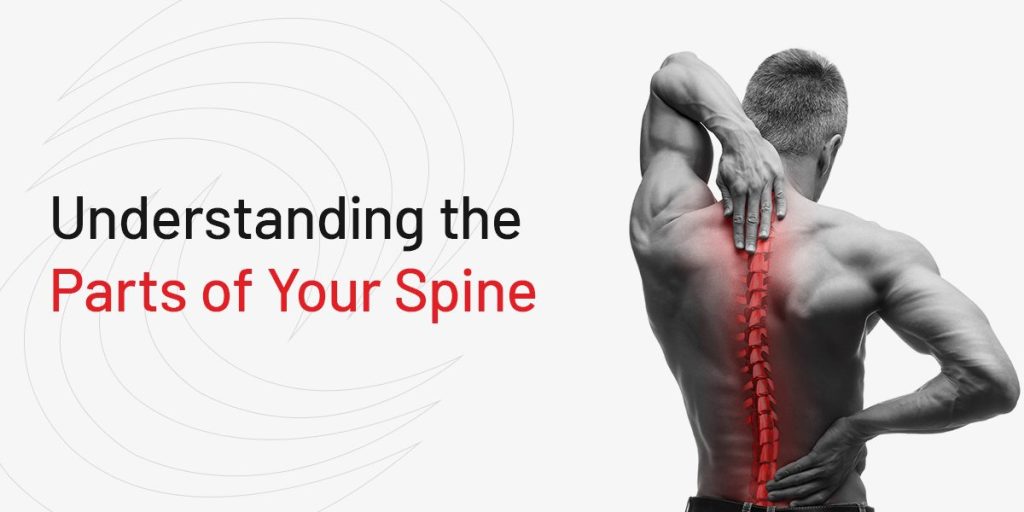
The spine is an important part of the body that provides support and allows for proper mobility. The spinal column is the supportive core of our bodies, while the spinal cord bridges the brain with the rest of the body. Many people may only notice or pay attention to the spine unless there is an issue or pain. Understanding the spinal column and spinal cord anatomy can help you protect yourself from potential injuries. Additionally, understanding the parts of the spine can also help you understand where pain or discomfort may be originating from.
Visit Here to Schedule An Appointment
The spine is one of the most essential structures of the body, allowing us to stand, walk and keep ourselves upright. First and foremost, the spine provides your body with proper support. The support of the spine is essential to various bodily movements and functions, such as standing and walking. Additionally, your spine allows for flexible movements, such as bending and twisting. Another function of the spine is that it protects the delicate spinal cord from potential damage. The spinal cord is a collection of nerves that connect the brain to the rest of the body, allowing for various movements and processes. The spinal cord helps the body and internal organs function properly. A healthy spine is a key aspect of leading a healthy lifestyle.
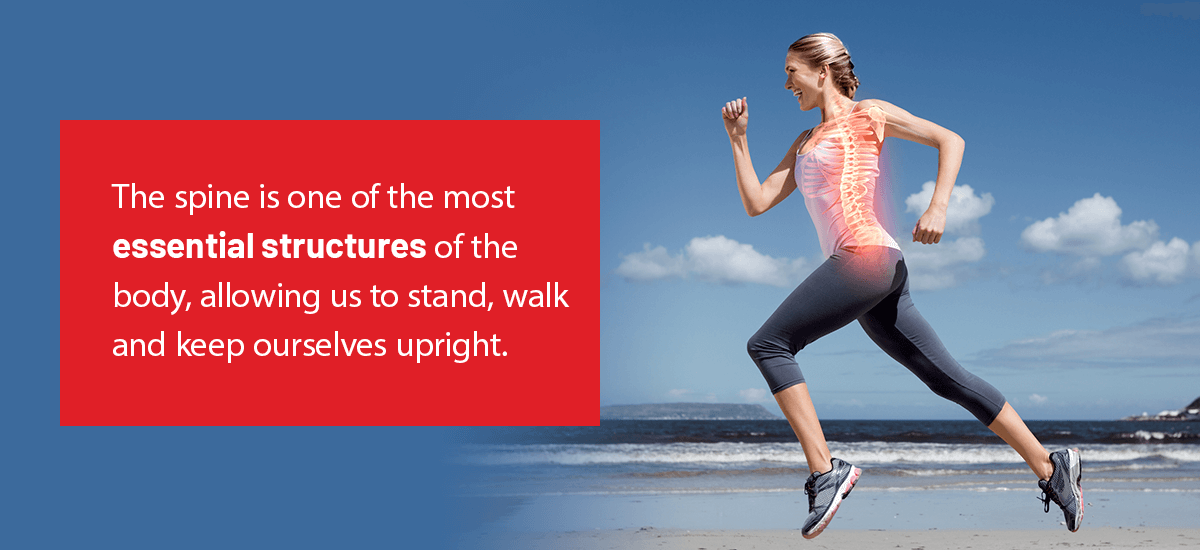
The spinal cord helps the body to move, determine the position of the legs and arms and even feel various stimuli, including hot, cold, sharp or dull sensations. Additionally, the spinal cord plays a vital role in controlling bodily functions like breathing and using the bathroom. Blood pressure, body temperature and heart rate are also regulated and controlled by the spinal cord and brain.
The spine is a complex structure that is responsible for providing support to the body. There are numerous areas of the spine that each has a unique function and helps the body perform vital processes. The various regions of the spinal column and cord work together to send messages from the brain to different areas of the body.
The back has four main parts, including the sacral, lumbar, thoracic and cervical regions. These parts of the spine make up the back anatomy, and each serves a unique purpose.
The sacrum is composed of five bones fused together into a triangular shape and situated behind the pelvis. The sacrum fits between the two hip bones and connects the pelvis to the spine. Immediately below the sacrum is the coccyx, also known as the tailbone, consisting of five fused bones.
The next portion of the spine is the lumbar spine, which consists of five vertebrae. These vertebrae are the largest of the spine and are responsible for carrying and supporting the majority of the body’s weight. The lumbar spine allows for a wider range of mobility than the thoracic spine but less mobility than the cervical spine.
The 12 thoracic vertebrae are located above the lumbar spine and below the last cervical vertebra. The thoracic vertebrae have longer spinous processes and are larger than the cervical bones. The uppermost portion of the spine makes up the neck region and is known as the cervical spine. The cervical spine comprises seven vertebrae that help protect the upper spinal cord and the brain stem.
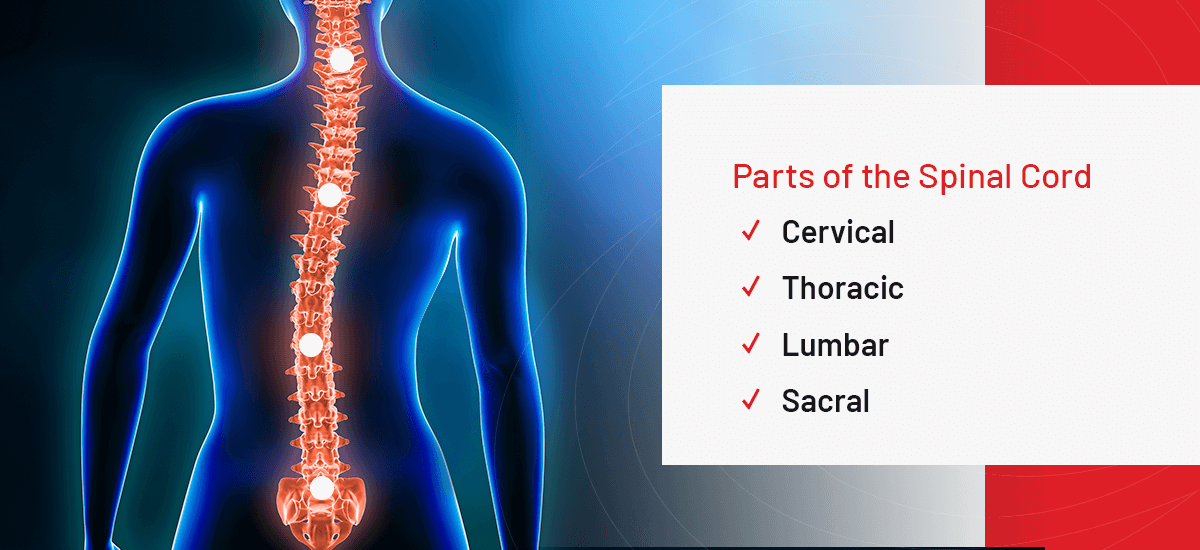
The spinal cord is an important structure between the brain and the body that carries nerve impulses between the brain and the spinal nerves. Similar to the spinal column, the spinal cord is divided into four sections, including the sacral, lumbar, thoracic and cervical regions.
The spine shows unique curves when viewed from the side. These curves are known as either kyphotic or lordotic curves. A kyphotic curve is a convex spinal curve found in the sacral or thoracic spinal segments. On the other hand, a lordotic curve is a concave spinal curve found in the lumbar or cervical portions of the spine.
The spinal column is made of 33 vertebrae, which are individual bones that interlock and connect with one another. Vertebral anatomy is divided and numbered depending on the region of the spine, including the vertebrae of the coccygeal, sacral, lumbar, thoracic and cervical regions. The top 24 vertebrae are mobile, while the vertebrae of the coccyx and the sacrum are fused. The spinal column is a tubular or tunnel structure protecting the spinal cord and sensitive spinal nerves from injury.
The cervical spine is the neck region that consists of seven vertebrae labeled C1 through C7 from top to bottom. The cervical vertebrae allow for a proper range of head and neck movement, support the skull and protect the spinal cord and brain stem. C1 is the first cervical vertebra, known as the atlas. C1 is a ring-shaped structure that helps support the skull.
The C2 is known as the axis, which is circular and features a blunt and tooth-like structure that projects upward into the C1. C1 and C2 allow the head to turn and rotate. The remaining cervical vertebrae are C3 through C7 and are box-shaped with small spinous projections extending from the back.
There are 12 thoracic vertebrae that lie under the last cervical vertebra and are labeled T1 through T12 from top to bottom. T1 is the smallest of the thoracic vertebrae, while T12 is the largest. Compared to the cervical vertebrae, the thoracic vertebrae are larger and have longer spinous processes. The thoracic vertebrae are limited in mobility as they are securely attached to the sternum and ribs.
The lumbar spine is comprised of five vertebrae that are abbreviated L1 through L5. The lumbar vertebrae are the largest vertebrae of the spine and support the majority of the body’s weight. The lumbar spine allows for greater mobility than the thoracic spine but less mobility than the cervical spine. The lumbar facet joints provide significant mobility and extension but limit rotation.
The facet joints contain cartilage that allows the vertebrae to slide along one another without pain or damage. Additionally, the facet joints also let you rotate, twist and turn, providing flexibility and stability. Because cartilage wears down over time, the facet joints may be susceptible to arthritis, causing chronic discomfort or pain in the back or neck.
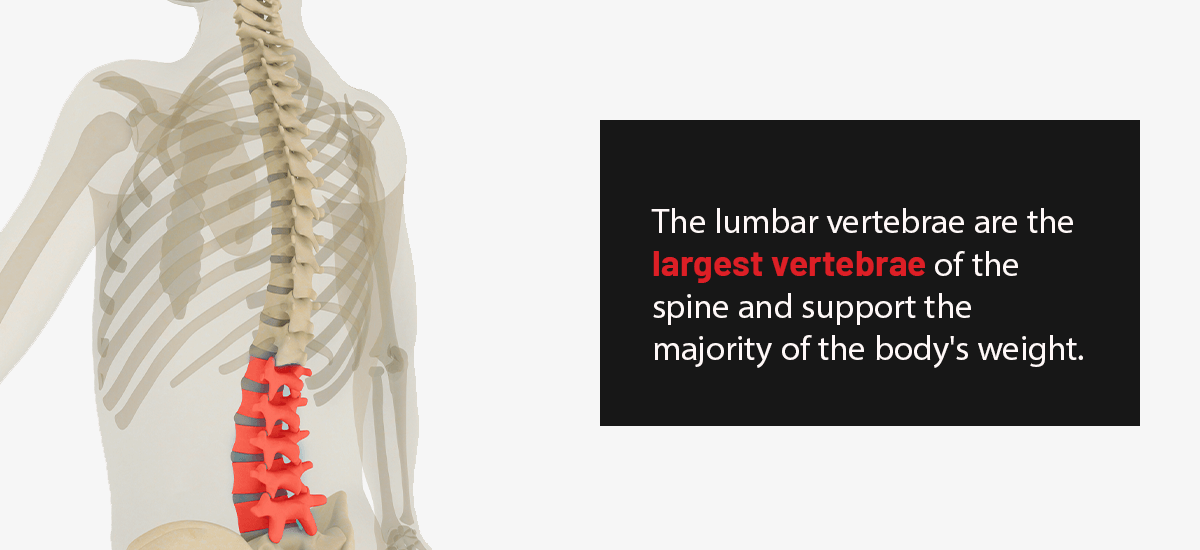
The sacrum is situated directly behind the pelvis and is composed of five bones labeled S1 through S5. The sacral bones are fused together and form a triangular shape. The sacrum connects the spine to the pelvis and fits between each hip bone. The final lumbar vertebra is known as L5 and moves in conjunction with the sacrum. Because the sacral vertebrae are fused, they do not allow for individual mobility. The hip bones and the sacrum form a ring that is commonly known as the pelvic girdle.
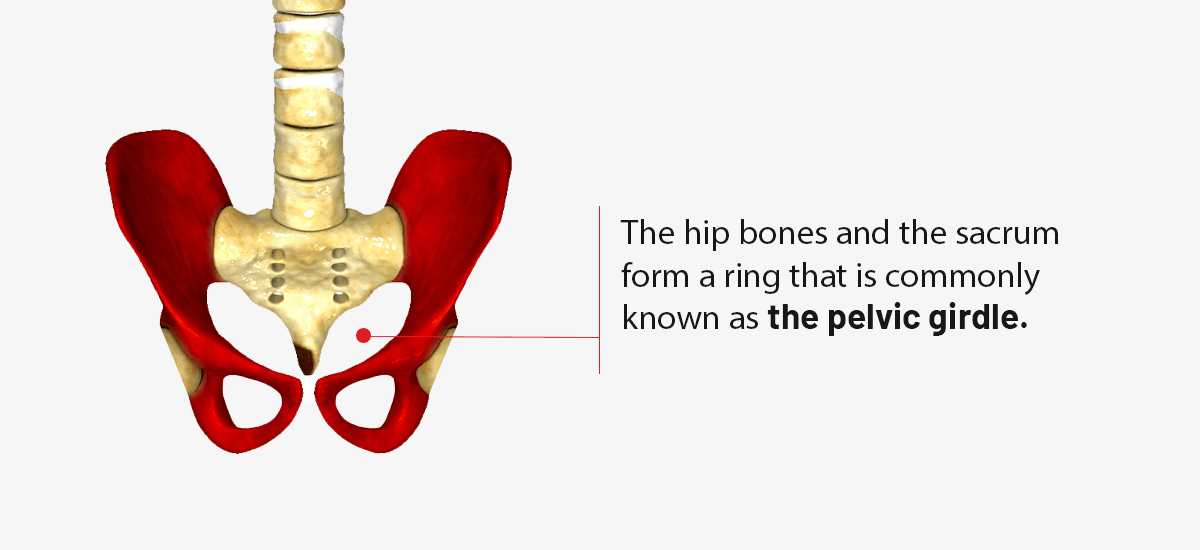
The coccyx, which is more commonly referred to as the tailbone, is comprised of four vertebrae fused together. The ligaments and pelvic floor muscles attach to the tailbone. Additionally, several ligaments, muscles and tendons connect to the tailbone. While the tailbone is much smaller than the sacrum, it plays an essential role in bearing weight. The tailbone is designed to support your body’s weight while you are sitting.
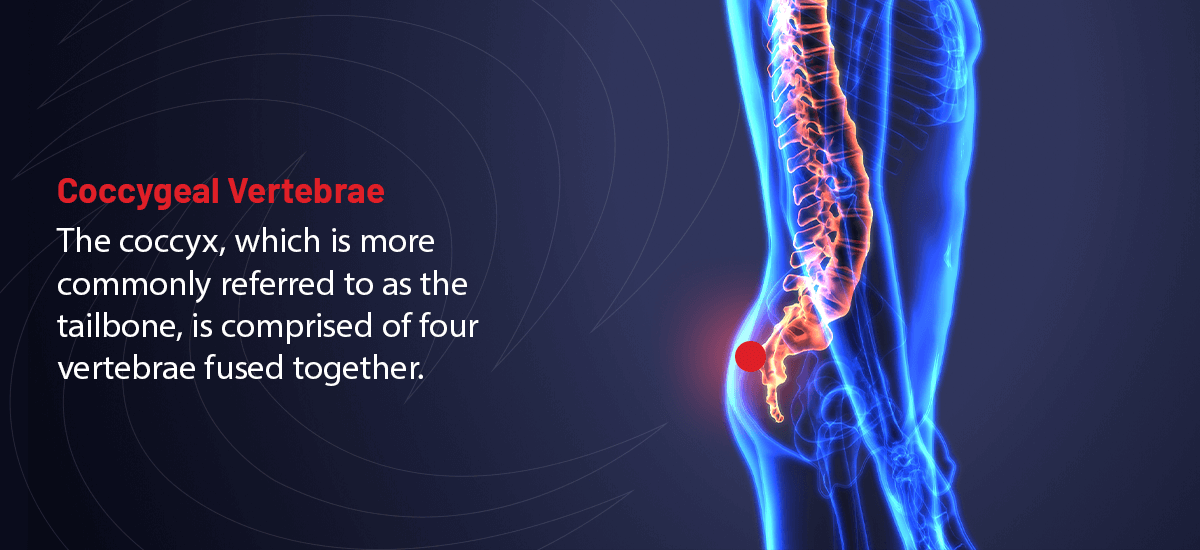
The spinal cord runs from the highest neck bone to the highest vertebra of the lower back, or from C1 to L1. The average spinal cord is approximately 18 inches and is relatively cylindrical. The brain and spinal cord are protected by three layers of membranes known as the meninges. The pia mater is the delicate inner layer, the arachnoid is the middle layer and the dura mater is the tougher outer layer.
The joints, skin and internal organs send specialized neurons to the spinal cord that help the brain recognize various sensations, including touch, pain, temperatures and vibrations. These messages are conveyed to the brain from the spinal cord through the lemniscal pathway or spinothalamic tract. Another important component of the spinal cord are the rexed lamina, including the:
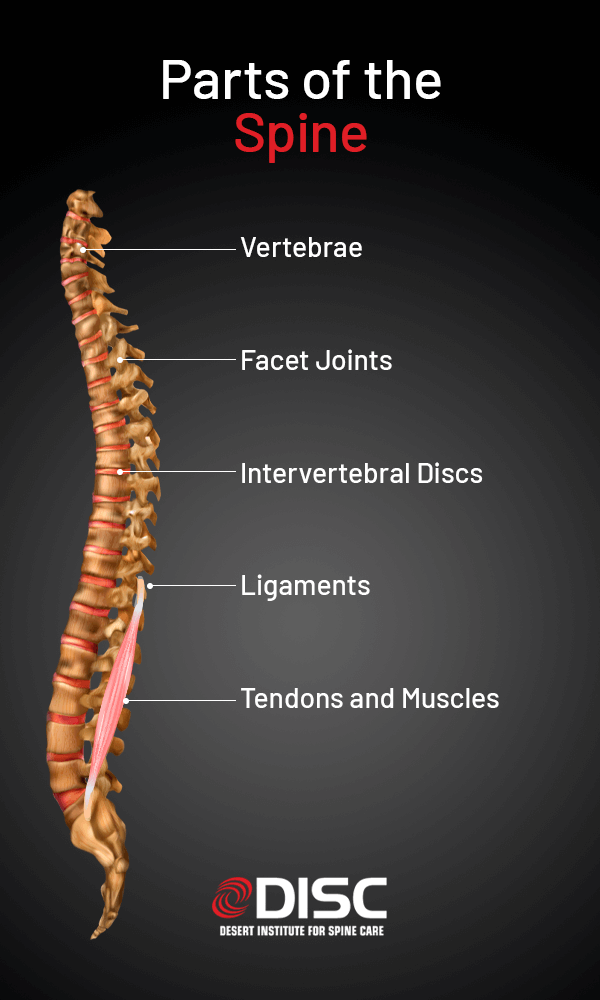
The various parts of the spine provide support and enable unique functions and mobilities. With time, the various parts of the back may wear down or degenerate. The degradation of healthy joints and aspects of the spine can lead to limited mobility, inflexibility and even acute or chronic back pain. In addition to chronic back pain, some of the most common spinal conditions include degenerative disc disease, herniated discs, facet joint syndrome, disc tears and more.
[widgetkit id=”61″]
The Desert Institue for Spinal Care (DISC) is an orthopedic spine center committed to offering innovative treatments and the highest level of patient care possible. Our team of surgeons and medical experts can help diagnose various spinal conditions and offer spinal treatments and endoscopic spine surgery. We are dedicated to providing compassionate and individualized care for each patient. To learn more about our spinal treatments, contact us online today or call (602) 944-2900.